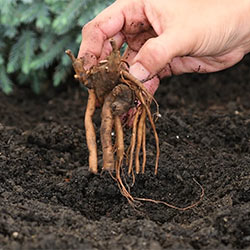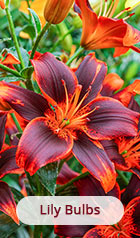
How to Plant, Grow, and Care for Dahlias
Not sure when to plant dahlias and how to take care of dahlias? Dahlias are some of our favorites for big, bold blooms in summer. They're also quite easy to grow-a surprise, given their tendency to astonish onlookers and win county fair prizes! Read on for tips for growing dahlias.
What Are Dahlias?
First: what are dahlias? Dahlias are grown from tubers that look somewhat like tiny potatoes. These beloved plants belong to the Asteraceae family, along with sunflowers, daisies, mums and zinnias. Nearly all dahlias feature blooms of rows upon rows of petals, and they're well-loved for their versatility in floral arranging.
What Makes Dahlias Special?
Dahlias are the darlings of many warm-weather gardens due to several reasons: their amazing blooms offer a long vase life, they add tons of height and color versatility to the garden, they bring a ton of color for just a little work.
Dahlias grow in a wide variety of sizes. These full blooms can be grown in miniature varieties as small as two inches or "dinnerplate" varieties up to one foot wide! Dinnerplate dahlias tend to grow several feet in height, while the shortest dahlias can be about 12 inches tall. Another thing gardeners love about dahlias: their bright and beautiful color. Dahlias come in nearly every hue! Cultivars of dahlias have produced in every color except for blue.
Types of Dahlias
Dahlias are such a varied and versatile group of flowers, it's hard to know where to begin when selecting them. Let's talk through some of the most common types of dahlias.
Border Dahlias
Border dahlias are spectacular in-that's right-borders. These shorter varieties grow to just over one foot in height, and feature pleasing double blooms. They look a bit like chrysanthemums, but bloom earlier in the summer and on longer stems, creating a less "bushy" look. However, these plants can be shaped and molded through the season. After the first round of blooms begin to fade, remove spent flower heads. Deadheading will encourage more blooms and create a bushier plant.
Anemone Dahlias
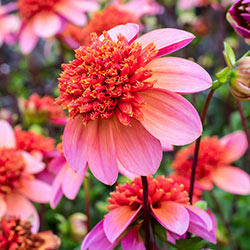
Anemone dahlias have a daisy-like shape, but their centers are actually composed of petals. Circling the center is an outer wreath of flat, larger petals. Totally cute and classic, anemone dahlias add a look of whimsy to borders or flower beds, and are attractive planted en masse.
Pompon Dahlias
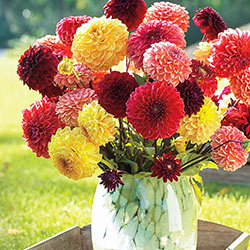
Pompon dahlias, sometimes called pincushion dahlias, are among the smallest-sized blooms in the dahlia genus. However, you'll find these little flowers absolutely enchanting! These wonderfully spherical blooms feature petals formed in a flawless spiral. Pompon dahlias are stunning in a mixed bouquet and a delight when displayed in a tabletop vase.
Dinnerplate Dahlias
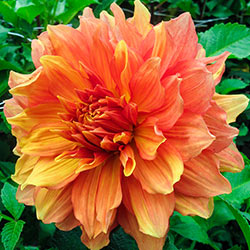
Dinnerplate dahlias are the largest-blooming type of dahlia-you won't believe these blooms are real. Dinnerplate dahlias can bloom eight to twelve inches across, and dazzle with their size and unique colors and textures. While these colossal blooms have heads the size of sunflowers, they actually grow to just a few feet in height. These large dahlias may require staking, but they're surprisingly tough and hardy.
And More Dahlias!
These are hundreds of dahlia varieties, in part because so many breeders are committed fans of this genus. Large, chrysanthemum-like blooms with interesting petal margins, pointed tips, and wavy textures are common. Other varieties are shaped like water lilies, and cactus dahlias feature unique, spiky looks. These flowers share a family resemblance, but there's an array of aesthetic options in the dahlia genus.
How to Plant Dahlia Bulbs
We'll send you your tubers when they're ready to plant! Setting them into their growing space is easy. First, you'll need to decide where you want to grow them.
How to Plant Dahlias Outside
You'll plant your dahlias in late spring, after all the danger of frost has passed. Remember, that last frost date is much later than those first springtime days. Research your region's true final frost time, so that your dahlias aren't frostbitten. Many regions have an easy "rule of thumb" for last frost-here in the Midwest, we commonly plant spring flowers around Mother's Day!
Choose a location with lots of sunlight-preferably more than six hours per day-and well-draining soil. Dahlias don't like to have "wet feet," so you want a spot where water doesn't settle. Now, you're ready to plant.
- Prepare your soil. Dahlias prefer rich soil, but it has to be well-draining. Enrich the soil with compost or loam, and aerate it well using a rake or spade. Make sure the soil is well-mixed, at least six inches deep, so that the roots of your dahlias will have an easy time spreading out.
- Add fertilizer to the soil. A balanced fertilizer, such as a 10-10-10, or one specifically formulated for dahlias, is a great choice. Mix in the fertilizer as you work the soil.
- Dig holes for your dahlia bulbs. Tubers should be planted one to three feet apart with the pointed end up. Most dahlia tubers will need to be planted a few inches below the soil surface, check the instructions included with your specific variety.
- Water to secure the bulbs, but water very lightly or not at all after planting is completed. You don't want to drown the tubers before they start to grow! Once growth is started, water once per week.
Growing Dahlias Indoors
If you live in a colder climate with a late final frost date, you might want to give your dahlias a head-start. You can achieve that by starting your dahlias indoors in containers-and, if you love the look of container dahlias, you can keep them growing in pots all summer.
If you plan to transplant dahlias from indoors to outside, start them about four to six weeks before your final frost date. Cover your tubers with about two inches of soil, and wait for them to sprout before watering. After the final frost date has passed, transplant them outdoors.
You can also start dahlias indoors and leave them in containers! This method works well with compact dahlia varieties, such as pompons or border dahlias, that won't outgrow their pots. Make sure to provide enough soil beneath the dahlias to allow their roots to grow. Large planters are excellent for this purpose, and planters at least a foot deep are best.
Caring for Dahlia Flowers
Proper care can ensure longevity for your dahlias and a bounty of healthy flowers. So, how can you best care for dahlias?
Watering Dahlias
Don't let your dahlias dry out! These flowers require regular watering. Water them once a week, soaking the ground. In hot, dry seasons, water them daily. And, remember that plants grown in containers dry out more quickly than plants in the ground.
Fertilizing Dahlias
Dahlias are good candidates for organic fertilizer, like compost or well-rotted manure, because they prefer rich soil. Try dressing them once at the beginning of the growing season. Then, use a low-nitrogen fertilizer once per month throughout the summer.
Staking Dahlias
Big-headed dahlias, like dinnerplates, may require staking to avoid bent stems. Using twine, loosely tie your dahlias to bamboo stakes about the height you expect the plants to grow. Or, try spiral stakes specifically made for tall flowers.
Deadheading Dahlias
Deadheading your plants after they bloom can keep them bushy and promote flowering. To deadhead a spent bloom, follow the flower stem down, and cut above the highest pair of leaves. Don't cut your dahlias down after blooming-leave their foliage to collect energy until it begins to die back naturally.
Lifting Dahlias
Dahlias are considered a "tender perennial" in the colder regions of the United States. If you live farther north than Zone 8, your dahlias may not come back after a winter in the ground. For many northern and midwestern gardeners, that means lifting dahlias and storing them for winter. Their tender roots need a cold period to restart growth, but they are no match for below-zero weather, so they're safest in a garage, basement, or refrigerator. Lift your dahlias in late fall, after the flowers and stems have died back.
To lift dahlias, simply dig them up with a spade. Brush excess soil off of the tubers. If the stems are still on the plant, snip stems to an inch or two of length. Next, set your dahlia tubers in a cool, dry place, spaced a few inches apart, to cure for 24 to 48 hours. Now they're ready to store. We recommend using brown paper bags or cardboard trays to keep them separated and easy to store. In springtime, you'll plant your dahlias again, just as you did the first time.
Pests and Diseases
Just like any plant, dahlias are susceptible to damage by bugs, fungus, and critters. Here are a few pests and diseases to watch out for:
- Slugs and snails: These slimy guys tend to eat the leaves of dahlias and other perennials. Baiting, or using beer traps, is an effective way to eliminate them.
- Earwigs and cucumber beetles: If you notice damage to the petals, but not the leaves, one of these two may be the culprit. Use neem oil or an insecticidal spray from your local garden center to rid your plants of these pests.
- Powdery mildew: Powdery mildew looks like fine dust, but it can stunt your dahlias' growth. It's common in damp, warm environments. Look for a commercially-available spray to treat this form of mildew.
- Deer: Unfortunately, deer love the tender texture of dahlia bulbs. Consider planting dahlias near deer-resistant plants. Several natural deer deterrents also exist on the market.
With just a little work, your dahlias are sure to stay happy and healthy. These beauties are well worth it, with a huge payoff for your time and effort!
Recommended Dahlia Bulb Varieties
Now that you're ready to garden with dahlias, what kind of dahlias will you plant? Check out a few of our best-sellers-these dahlias are beloved by new and veteran gardeners alike.
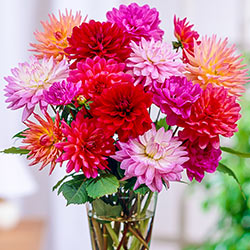
Karma Dahlia Mix. This delightful mix is perfect for beginners! Karma includes dahlias in different colors, each blooming to a big-but-not-massive six to eight inches in width. These dahlias bloom on super-sturdy stems, so they're perfect for cutting.
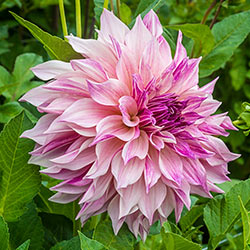
Cafe au Lait Royal Dahlia. The original Cafe au Lait Dahlia is a pink dinnerplate dahlia, and now its purple sister has burst onto the scene for weddings and parties. This dahlia features beautiful white-to-lavender petals with elegantly pointed tips, and its flowers are eight to ten inches wide. Huge and stunning!
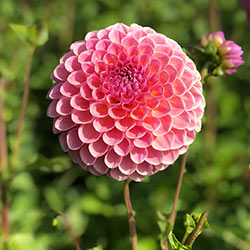
Jowey Winnie Dahlia. Plant a fun and wild look with a bright pink pink pompom! We love this one for its nearly perfect spherical shape. It just looks like something out of a children's picture book, and it's gorgeous in bouquets.
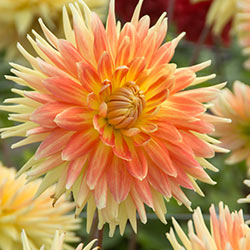
Motto Dahlia. If you love the look of big and bold football mums, you'll want to check out Motto. Another dinnerplate dahlia, this one features wide apricot blooms with long, curled petals. The center is a rosy orange tone, and all this color is just a delight borne on three-foot-tall stems.
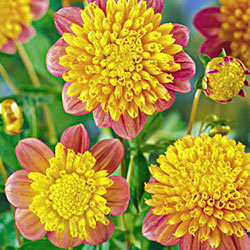
Honey Anemone Dahlia. Catch the buzz about anemone dahlias with this sweet, honeybee-yellow variety. A pincushion of tightly packed yellow florets sits in the center of a slightly flattened ring of peachy-pink petals. Anemone dahlias are known for being weird and whimsical, and this one definitely fits that bill. Anemone varieties tend to be avoided by deer, too!
There are so many fantastic dahlias well-suited to any landscape, porch or patio. For more inspiration, visit our dahlia page
here.
Have another question? Return to the Customer Service Help page or send an e-mail directly to Customer Service
